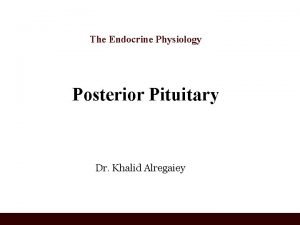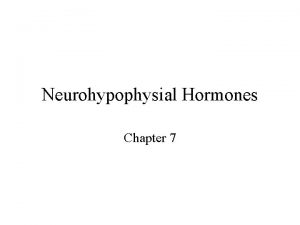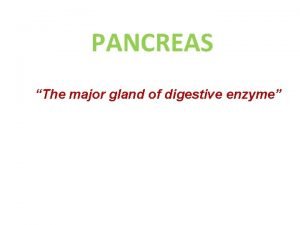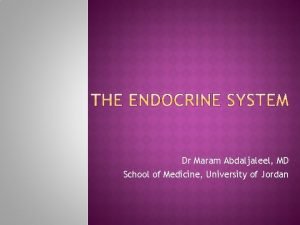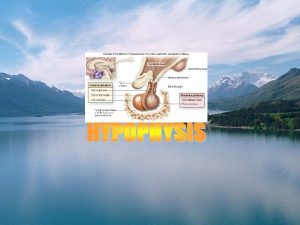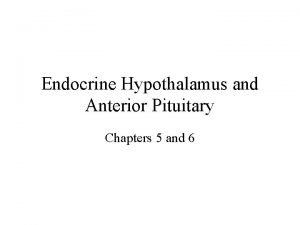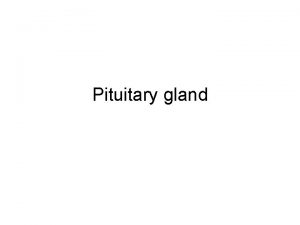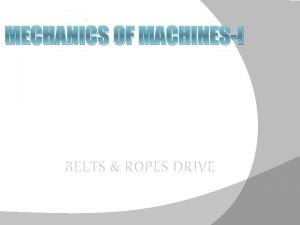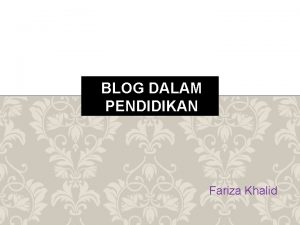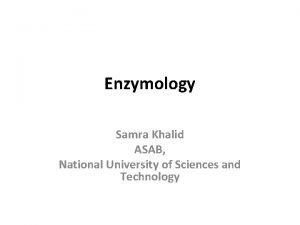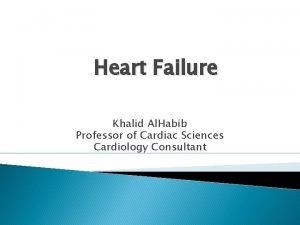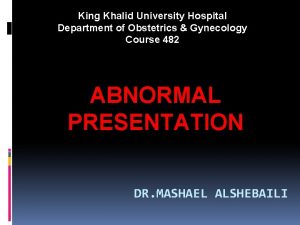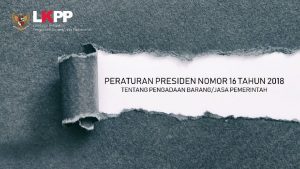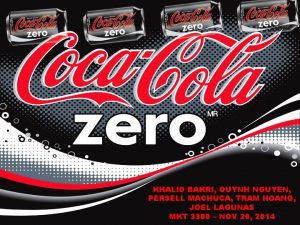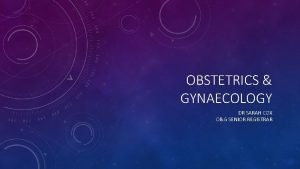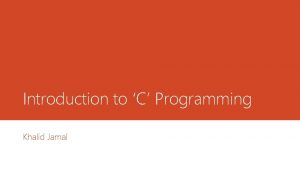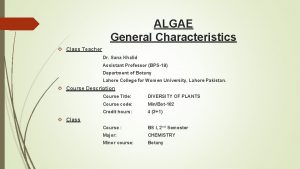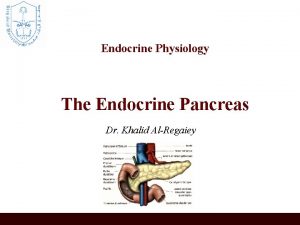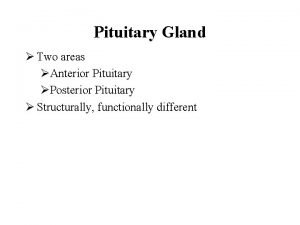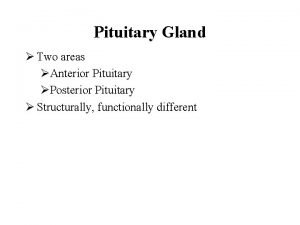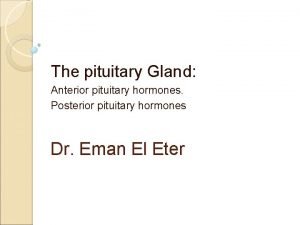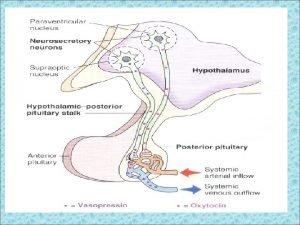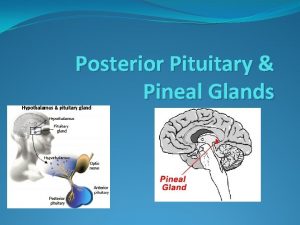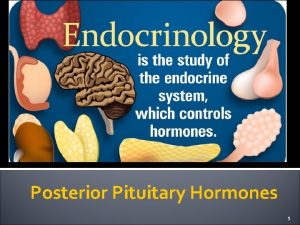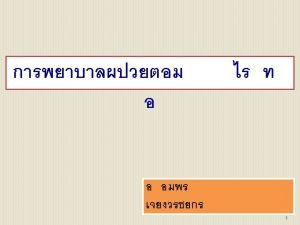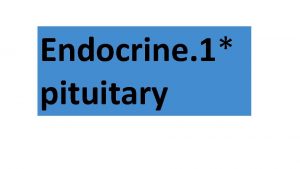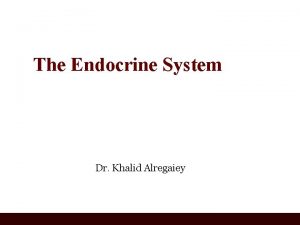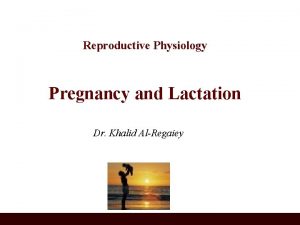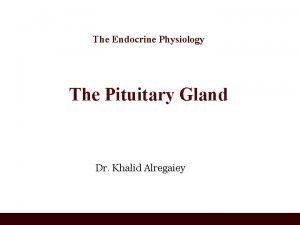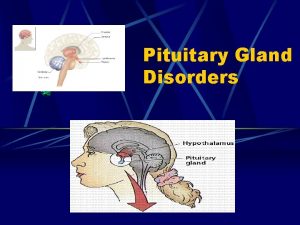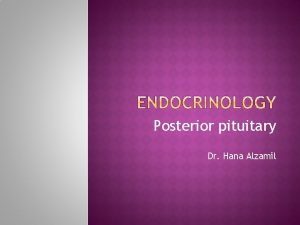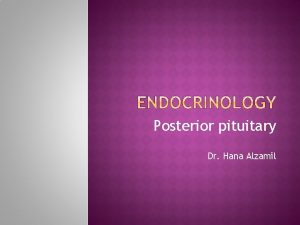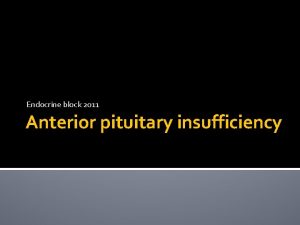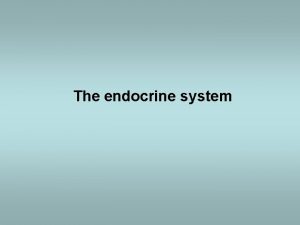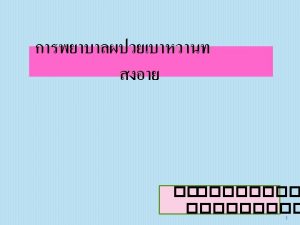The Endocrine Physiology Posterior Pituitary Dr Khalid Alregaiey
























- Slides: 24

The Endocrine Physiology Posterior Pituitary Dr. Khalid Alregaiey

Learning Objectives • Describe the posterior pituitary relationship with the hypothalamus • List the target organs and functional effects of oxytocin. • Name the stimuli for oxytocin release in relation to its reproductive and lactation functions. • List the target cells for vasopressin and explain why vasopressin is also known as antidiuretic hormone. • Describe the stimuli and mechanisms that control vasopressin secretion. • Identify disease states caused by a) over-secretion, and b) under-secretion of vasopressin and list the principle symptoms of each.

Pituitary (Hypophysis)

Pituitary (Hypophysis)

The Posterior Pituitary and Hypothalamic Hormones • The posterior lobe is a downgrowth of hypothalamic neural tissue • Has a neural connection with the hypothalamus (hypothalamichypophyseal tract) • Nuclei of the hypothalamus synthesize oxytocin and antidiuretic hormone (ADH) • Their axons terminate in the posterior pituitary

Oxytocin and Vasopressin • Vasopressin: Cys-Tyr-Phe-Gln-Asn-Cys-Pro-Arg-Gly. NH 2 • Oxytocin: Cys-Tyr-Ile-Gln-Asn-Cys-Pro-Leu-Gly. NH 2

Posterior pituitary • Does not synthesize hormones • Consists of axon terminals of hypothalamic neurons

Secretion of Posterior Pituitary Hormones

Oxytocin

Synthesis of Oxytocin • Oxytocin is synthesized in the cell bodies of hypothalamic neurons (paraventricular nucleus) • Oxytocin is stored in the posterior pituitary

Functions of oxytocin • Oxytocin is a strong stimulant of uterine contraction • Regulated by a positive feedback mechanism • This leads to increased intensity of uterine contractions, ending in birth • Oxytocin triggers milk ejection (“letdown” reflex) Contracts the myoepithelial cells of the alveoli • Increases contraction of smooth muscle of the vas deferens, helping in the ejaculation process.

Antidiuretic Hormone (ADH) (vasopressin)

Synthesis of ADH • It is synthesized as pre-prohormone and processed into a nonapeptide (9 amino acids) • ADH synthesized in the cell bodies of hypothalamic neurons(supraoptic nucleus) • ADH is stored in the posterior pituitary

Receptors of ADH (vasopressin) • There are 2 types of receptors for ADH: • V 1 • V 2 V 1 receptors mediate vasoconstriction V 2 receptors are located in the principle cells in distal convoluted tubule and collecting ducts in the kidneys

Mechanism of action of ADH

Control of ADH Release • Osmotic pressure: • Osmoreceptors in the hypothalamus: • osmotic pressure ADH secretion • osmotic pressure ADH secretion • Blood volume : • Baroreceptor in carotid artery and aortic arch, and left atrium: • blood pressure ADH secretion • Pain, fear, trauma, and stress

Regulation of ADH Hypothalamus receives feedback from: • • Osmoreceptors Aortic arch baroreceptors Carotid baroreceptors Atrial stretch receptors Any increase in osmolality or decrease in blood volume will stimulate ADH secretion from posterior pituitary.

ADH V 1 receptor Increased Blood Pressure

ADH Disorders • Diabetes Insipidus: Neurogenic (central): (failure of hypothalamus or neurohypophysis to synthesize or secrete ADH) Nephrogenic: (failure of the kidney to respond appropriately to ADH) • Syndrome of Inappropriate Antidiuretic Hormone (SIADH)

DIABETES INSIPIDUS • DI is a disorder resulting from deficiency of antidiuretic hormone (ADH) or its action and is characterized by the passage of copious amounts of dilute urine. • It must be differentiated from other polyuric states such as primary polydipsia & osmotic duiresis. Central DI is due to failure of producing adequate ADH.

DIABETES INSIPIDUS • Nephrogenic DI results when the renal tubules of the kidneys fail to respond to circulating ADH. • The resulting renal concentration defect leads to the loss of large volumes of dilute urine. This causes cellular and extracellular dehydration and hypernatremia.

Treatment • DESMOPRESSIN (DDAVP) A SYNTHETIC ANALOG IS SUPERIOR TO NATIVE AVP BECAUSE: • IT HAS LONGER DURATION OF ACTION (810 h vs 2 -3 h) • MORE POTENT • ITS ANTIDIURETIC ACTIVITY IS 3000 TIMES GREATER THAN ITS PRESSOR ACTIVITY

Treatment of Nephrogenic DI • CORRECTION OF UNDERLYING CAUSE • PROVISION OF ADEQUATE FLUIDS & CALORIE • LOW SODIUM DIET • DIURETICS • HIGH DOSE OF DDAVP

Summary of posterior pituitary hormones actions
 Hypophysis
Hypophysis Difference between anterior and posterior pituitary
Difference between anterior and posterior pituitary Renal angle
Renal angle Anterior pituitary
Anterior pituitary Htpothalamus
Htpothalamus Difference between anterior and posterior pituitary
Difference between anterior and posterior pituitary The embryonic origin of the anterior pituitary gland is
The embryonic origin of the anterior pituitary gland is Fariza meaning
Fariza meaning Khalid farhan course google drive
Khalid farhan course google drive Fariza khalid
Fariza khalid Khalid chaouch
Khalid chaouch Dr samra khalid
Dr samra khalid Khalid karaoui
Khalid karaoui Dr khalid waheed
Dr khalid waheed Khalid al habib
Khalid al habib King khalid hospital
King khalid hospital Khalid bazaid
Khalid bazaid Khalid mustafa
Khalid mustafa Khalid hossain books
Khalid hossain books Dr. khalid bazaid
Dr. khalid bazaid Nauman khalid md
Nauman khalid md Khalid bakri
Khalid bakri Dr sarah cox
Dr sarah cox Dr khalid jamal
Dr khalid jamal Dr sana riaz
Dr sana riaz
